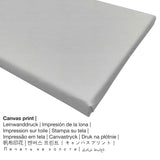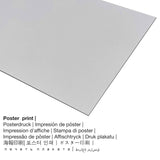Jean Marc Nattier, 1749 - Madame Marsollier and Her Daughter - fine art print
Tax included. Shipping calculated at checkout.
Article overview
The classic art artpiece Madame Marsollier and Her Daughter was made by Jean Marc Nattier. The original measures the size: 57 1/2 x 45 in (146,1 x 114,3 cm). Oil on canvas was applied by the French painter as the medium of the masterpiece. Nowadays, the work of art can be viewed in in the The Metropolitan Museum of Art's art collection, which is located in New York City, New York, United States of America. With courtesy of The Metropolitan Museum of Art, New York, Bequest of Florence S. Schuette, 1945 (public domain). Creditline of the artwork: Bequest of Florence S. Schuette, 1945. The alignment of the digital reproduction is portrait and has a ratio of 3 : 4, meaning that the length is 25% shorter than the width.
Order the material of your choice
For every product we offer a range of different sizes & materials. We allow you to pick your favorite size and material among the following product individualization options:
- The poster print (canvas material): The Artprinta poster print is a printed canvas with a nice structure on the surface. The print poster is perfectly suited for putting your art replica with a custom-made frame. Please bear in mind, that depending on the size of the poster we add a white margin 2-6cm around the print, which facilitates the framing with your custom frame.
- Acrylic glass print (with real glass coating): The acrylic glass print, often labelled as a plexiglass print, will change your favorite artwork into wonderful home décor. Your work of art is made with modern UV print machines. With an acrylic glass fine art print contrasts and smaller color details will be exposed thanks to the granular gradation. Our real glass coating protects your chosen art replica against sunlight and external influences for many years to come.
- The canvas print: The UV printed canvas material mounted on a wooden stretcher frame. A canvas creates the sculptural impression of three dimensionality. A printed canvas of your favorite artwork will let you turn your individual art print into a large artwork like you would see in a real gallery. Canvas prints are relatively low in weight, which implies that it is easy and straightforward to hang up the Canvas print without extra wall-mounts. A canvas print is suited for all types of walls.
- Aluminium dibond print: An Aluminium Dibond print is a print with an outstanding depth effect - for a modern look and a non-reflective surface. The Direct Print on Aluminum Dibond is the best start to fine art replicas produced with aluminum. The colors are luminous, the details appear crisp. The print on aluminium is one of the most popular entry-level products and is a truly sophisticated way to display art prints, because it draws focus on the image.
Legal disclaimer: We try all that we can in order to describe our products with as many details as we can and to demonstrate them visually. Please keep in mind that the colors of the printed materials and the printing may differ marginally from the image on the screen. Depending on the screen settings and the nature of the surface, colors might not be printed as realistically as the digital version depicted here. In view of the fact that the are processed and printed manually, there may as well be slight discrepancies in the motif's size and exact position.
About this item
| Product classification: | art print |
| Reproduction: | digital reproduction |
| Manufacturing method: | UV print / digital printing |
| Product Origin: | Germany |
| Type of stock: | on demand production |
| Product usage: | home design, wall decoration |
| Artwork orientation: | portrait alignment |
| Image aspect ratio: | 3 : 4 length : width |
| Interpretation of image ratio: | the length is 25% shorter than the width |
| Item material variants: | acrylic glass print (with real glass coating), canvas print, poster print (canvas paper), metal print (aluminium dibond) |
| Canvas on stretcher frame (canvas print) options: | 30x40cm - 12x16", 60x80cm - 24x31", 90x120cm - 35x47", 120x160cm - 47x63" |
| Acrylic glass print (with real glass coating) variants: | 30x40cm - 12x16", 60x80cm - 24x31", 90x120cm - 35x47", 120x160cm - 47x63" |
| Poster print (canvas paper) size options: | 30x40cm - 12x16", 60x80cm - 24x31", 90x120cm - 35x47" |
| Aluminium print (aluminium dibond material) size options: | 30x40cm - 12x16", 60x80cm - 24x31", 90x120cm - 35x47" |
| Framing of the art reproduction: | without frame |
Piece of art table
| Title of the artwork: | "Madame Marsollier and Her Daughter" |
| Categorization of the work of art: | painting |
| Category: | classic art |
| Period: | 18th century |
| Artpiece year: | 1749 |
| Approximate age of artwork: | over 270 years |
| Artwork original medium: | oil on canvas |
| Dimensions of the original artpiece: | 57 1/2 x 45 in (146,1 x 114,3 cm) |
| Museum / location: | The Metropolitan Museum of Art |
| Place of museum: | New York City, New York, United States of America |
| Available at: | The Metropolitan Museum of Art |
| Artwork license type: | public domain |
| Courtesy of: | The Metropolitan Museum of Art, New York, Bequest of Florence S. Schuette, 1945 |
| Creditline of artwork: | Bequest of Florence S. Schuette, 1945 |
Artist overview table
| Artist: | Jean Marc Nattier |
| Gender: | male |
| Artist nationality: | French |
| Jobs: | painter |
| Country: | France |
| Artist category: | old master |
| Life span: | 81 years |
| Year of birth: | 1685 |
| Year of death: | 1766 |
© Copyright - intellectual property of, Artprinta.com (Artprinta)
Artwork depiction by the museum's website (© - by The Metropolitan Museum of Art - www.metmuseum.org)
Madame Marsollier was married, beneath her station, to a Parisian textile merchant whose shop was in the rue Saint-Honoré. Her portrait, exhibited at the Salon in 1750, displays in full measure the luxury fabrics that were the source of his fortune. The lady and her child are en déshabille, in revealing draperies that accentuate their pearly skin. It is not surprising that the wealthy couple would have commissioned a large portrait from Nattier, who was then the preeminent painter of the French royal family.














